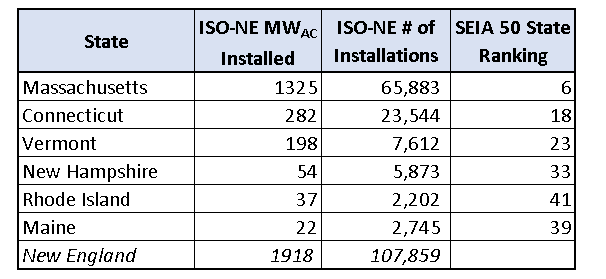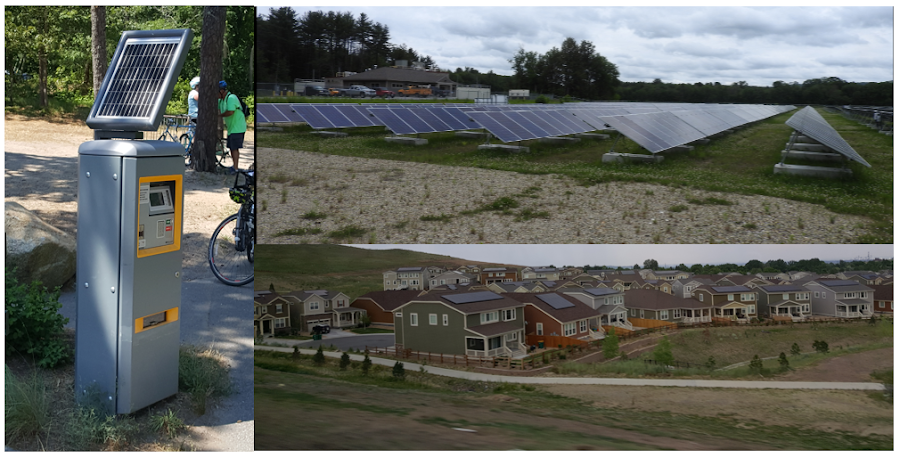There are a few important points to take from this chart.
- There was a run up in NH electricity prices in the early 1990s followed by a fall off around the start of the millennium, and since 2003 we have seen an almost consistent price increase year after year. Since 1990, retail prices for electricity in the US have increased by 60%, whereas those in NH have increased by 87%.
- In 2018, electricity prices in NH were 62% higher than the national average. This is the largest difference since the mid-1990s.
As high as our electrical charges are, we need to appreciate that electrical rates are only one component of our electrical bills. The other important piece is how much electricity we use. I used the same data source and calculated the average monthly electricity consumption for each household in NH and the US for the same time period. The data are plotted below. I was impressed to note that the average NH electrical consumption has hovered around 600 kWh/month for the last 28 years, whereas the average consumption for the US has increased from 800 to 900 kWh/month.
Combining average monthly consumption and the retail electricity rates (via multiplication) yields the result that in 2018 the average NH electrical bill was $122/month vs. $118 for the US. That is a substantially smaller difference than I expected and has made me a little less fretful about electricity prices in NH. Yes, they are among the highest in the US, but our Yankee frugality combined with our lower dependence on electrical heating and air conditioning, as well as investments in energy efficiency, have led us to electrical bills that are very much on a par with the average for the US.
There is another way to analyze these numbers. I took the monthly bills, annualized them, and calculated them as a percent of the average annual household income, which I assembled from US Census data. For NH, the number in 2018 is 1.7%, which is down from 2.3% in 1990. The equivalent average numbers for the US have risen from 1.6% to 2.2% over the 1990–2018 time period. This indicates that, as a percent of household income, electrical bills in NH are lower than the US average.
All things considered, I think paying 1.7% of our income for reliable electricity supply that is there at a click of a switch is a small price to pay. However, this does not mean that we should not be concerned about electricity costs in NH. We should. My calculations use an average household income of $81,000 for NH. If you are earning substantially less than that amount, your costs for electricity can very quickly balloon to over 5% of your income and, if you are watching your pennies, every rate increase has a significant impact.
Whenever I look at historical electrical rates, I think about the impact of deregulation, which started in 1997 in NH and was only recently completed with the final sale of Eversource’s generating assets in 2018. As I have written in previous blog posts, deregulation required that electrical utilities get out of the electricity-generating business, but left them with the transmission and distribution monopolies in their service area. As a result, NH ratepayers now have the opportunity to purchase power from competitive suppliers or from their utilities who have to go into the open market to procure that electricity from independent generators.
The whole point of deregulation was to remove the monopoly of the utility and to bring competition into the electricity supply business and that prices would fall as a result. After 20+ years of deregulation, the results for NH have been a bit of a mixed bag. Yes, the large industrial and commercial enterprises in the state have benefited and, as individual rate payers, we now can choose who we buy electricity from, but, as the previous chart showed, it has certainly not brought down residential electricity prices.
In the Energy and Sustainability courses I teach at Franklin Pierce University, my students and I spend a fair amount of time debating the success of deregulation efforts in the US. There are now 17 states that have some form of electricity deregulation and it is hard to point at any fabulous success stories, whereas some stunning disasters, such as California’s attempts at deregulation and the subsequent bankruptcy of some of its largest utilities, have ensued.
I am always interested in good ideas and novel experiments: my view of deregulation is that it has been both of these. However, what is more important is looking back and understanding if these experiments and ideas have worked and, if they haven’t, perhaps we should consider trying something else.
With that said, I followed the approach of the folks from the American Public Power Association, who took a look at residential electrical rates from 1997, which is considered the first official year of electricity deregulation in the US . I looked at data for NH, and the US (this includes data from the chart above) as well as for the deregulated states (which include NH, MA, ME, RI, CT, NY, NJ, DE, IL,CA, MI, OH, TX, DC, MT, MD). This is presented in the chart below, along with some data in the accompanying table.
We can observe that, in all cases, there have been overall price escalations, but for NH and the other deregulated states, the increases started from a higher base. The challenge with this data is how do we compare the relative increases – do we do this on the basis of the overall increase, the average annual increase, or the compounded annual growth rate, and, most importantly, what do we use as our time frame and starting date? In the table, I present data for the overall nominal and percent increases from a starting point to 2018. I chose three start dates for the comparisons: the first was 1997 – the date when deregulation became law in NH; the second was 2002, the year of the lowest NH electricity prices since deregulation; and 2012, which is when, based on the data, residential customer choice really kicked in at Eversource, the largest utility in NH.
In the first case, the data show that overall percent increases for electricity in NH and the deregulated states from 1997 were lower than those for the regulated states and the US overall because they started from a higher base. However if we use 2002 or 2012 as the base year, the increases for NH are substantially greater than for the US, the deregulated states, and the regulated states.
These analyses and comparisons are further complicated because deregulation only deals with the electricity-supply portion of the overall electricity price, which is about 60% of our overall electrical rates. There are a lot of factors baked into our electricity prices. There is the cost of electricity, which includes wholesale costs, long-term supply contracts, as well as the necessity to source renewable energy required by the renewable portfolio standard. And then there are transmission, distribution costs, systems benefit charges, service fees, and penalties for past mistakes and regulatory changes (in the form of stranded costs) and well as built-in profits for the utilities.
At this time, there is little evidence that residential rate payers in NH have benefited from deregulation. Although the large industrial and commercial users in the state have profited from the changes, I am hard pressed to make the case that deregulation has been good for residential rate payers. Yes, we can now choose to buy electricity from suppliers that source from renewable power generators (at a higher cost) and some might propose that deregulation had an impact by inhibiting larger prices increases. This is a weak argument to make because lower wholesale prices, driven by lower natural gas prices, have had a larger mitigating effect on price increases than deregulation.
Further evidence of the small impact that deregulation has had on residential rate payers in NH is the observation that only ~20% of NH residences have elected to go with a competitive provider. Moreover my recent review of electricity offerings from competitive suppliers shows that, in most cases, the default rates offered by the local utilities rates are, at this time, mostly lower than the competitive suppliers operating in the state. There are exceptions, but the differences are generally small and generally do not last over time. Not only are there concerns that deregulation has not benefited rate payers, but recent studies from other states have shown that residential rate payers have been penalized for participating in the competitive electricity supply market and that low-income customers suffer the bulk of the harm.
Deregulation seemed like a good idea at the time: we have tried it out but it has not worked out the way we thought it would. There have been benefits, but, in this case, competition and the “invisible hand” of the market have not led to lower residential rates. I think it is now time for us to take a long hard look at this experiment and to figure out if there is a better way. NH was the first state to the deregulation party and we should be the first to take a deep data-driven look at alternatives. I will be taking a closer look at this issue in future blogs. In the meantime, do your bit and turn off the lights when you leave the room.
Mike Mooiman
Franklin Pierce University
mooimanm@franklinpierce.edu
Click on this link to receive email notifications for Energy in New Hampshire updates
PS: For those of you interested in looking at competitive electricity rates, the NH Public Utilities Commission now publishes information about the competitive suppliers and their rates on the PUC website at the following link. https://www.puc.nh.gov/ceps/shop.aspx




















